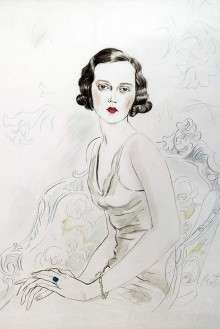Sheila Chisholm
Margaret Sheila Mackellar Chisholm (9 September 1895 – 13 October 1969) was an Australian socialite and "it girl" in British high society during and after World War I. She married three times: Francis St Clair-Erskine, Lord Loughborough (heir to the 5th Earl of Rosslyn); Sir John Charles Peniston Milbanke, 11th Bt; and Prince Dmitri Alexandrovich of Russia. Chisholm also had close relationships with brothers George VI and Edward VIII, both future Kings of the United Kingdom. Chisholm's romantic liaison with George ended when his father, George V, told him to leave the already-married Australian and find someone more suitable.
| Sheila Chisholm | |
|---|---|
| Lady Loughborough Lady Milbanke Princess Dmitri Alexandrovich of Russia | |
 Portrait of Chisholm by Cecil Beaton, 1930 | |
| Born | Margaret Sheila Mackellar Chisholm 9 September 1895 Woollahra, New South Wales, Australia |
| Died | 13 October 1969 (aged 74) London, England |
| Spouse | Francis St Clair-Erskine, Lord Loughborough (divorced) Sir John Charles Peniston Milbanke, 11th Bt (divorced) Prince Dmitri Alexandrovich of Russia (m. 1954) |
| Father | Harry Chisholm |
| Mother | Margaret Mackellar |
Known for her striking beauty, she is likely the inspiration for the Australian phrase "a good-looking sheila".[1]
Family and early years
Sheila Chisholm was born on 9 September 1895 on the family property "Wollogorang", the centre of the locality now called Wollogorang, near Breadalbane, New South Wales, youngest child and only daughter of grazier Harry Chisholm and his wife Margaret, née Mackellar.[2] Her paternal great-grandfather was Scottish and arrived in Australia with the Second Fleet in 1790.[3] The Chisholms became wealthy members of the Squattocracy in New South Wales, and she was raised on "Wollogorang" with her two older brothers, John and Roy.[2] As the only girl in a rough, male-dominated world, she often attempted to match and outdo the working men at tasks on the station. She recalled how she liked to "go out further than the furthest man" when swimming at Bondi Beach, until she witnessed a man lose his leg in a shark attack.[4] Chisholm was also attracted to the arts and had a deep appreciation for Australia's flora and fauna.[5] In her unpublished memoir, Waltzing Matilda, she described her adolescent self as "a queer mix of romanticism and boyishness ... I was quite unconscious of my looks".[6]
Adult life

In 1914, Chisholm and her mother sailed to England on the SS Mongolia.[7] They planned to spend months in Europe, but their trip was extended by the onset of the First World War, making the long journey back to Australia too dangerous.[7]
Chisholm and her mother travelled to Cairo where one of her brothers was stationed with an Australian cavalry regiment.[8] In Cairo, Chisholm met the first of her three husbands, Lord Loughborough.[8] Loughborough was a compulsive gambler, later immortalised as 'the Man who Broke the Bank at Monte Carlo'.[8] The couple had two sons together.[7]
At the end of 1918, Chisholm met Bertie, the future George VI.[9] Bertie's older brother, Edward, Prince of Wales, had fallen in love with her best friend, Freda Dudley Ward.[9] They called themselves The Four Do's.[9] In April 1920, Bertie ended his relationship with the still married Chisholm in return for a dukedom awarded by his father.[9]
Chisholm dated Italian-American actor Rudolph Valentino, who gifted to her his "lucky bracelet". He died six months later, causing Chisholm to think it was because she had taken his luck. She inspired British author Evelyn Waugh to write his celebrated 1948 novel The Loved One.[10]
Death and legacy
Chisholm is buried at Rosslyn Chapel.[7] Her son commissioned a stained glass window of St Francis of Assisi surrounded by animals which can be seen in the chapel’s baptistry.[7] In a nod to Chisholm's Australian heritage, there is a kangaroo in the bottom left hand corner of the window.[7]
Chisholm had fallen into obscurity by the time of her death and was almost completely forgotten until the publication of journalist Robert Wainwright's 2014 biography Sheila: The Australian Beauty Who Bewitched British Society.[1]
References
- "A Sheila who captured London's heart" (28 February 2014), SBS. Retrieved 14 March 2015.
- Wainwright 2014, pp. 2–3.
- Wainwright 2014, p. 4.
- Wainwright 2014, p. 12.
- Wainwright 2014, pp. 15–16.
- Wainwright 2014, p. 8.
- "Remarkable journey of Margaret Sheila Mackellar". www.scotsman.com. Retrieved 2019-11-18.
- "Australia's entrancing Sheila". The Spectator. 2014-02-01. Retrieved 2019-11-18.
- McGinness, Mark (2014-02-28). "Hitting it off with the toffs". The Sydney Morning Herald. Retrieved 2019-11-18.
- Simpson 1993.
Bibliography
Books
- Wainwright, Robert Wainright (2014). Sheila: The Australian Beauty Who Bewitched British Society. Allen & Unwin. ISBN 9781743311318.CS1 maint: ref=harv (link)
Webpages
- Simpson, Caroline (1993). "Chisholm, Margaret Sheila". Australian Dictionary of Biography. Retrieved 14 March 2015.CS1 maint: ref=harv (link)
External links
- Biographer Robert Wainwright discusses Sheila Chisholm on "Conversations" with Richard Fidler, ABC Local Radio